My primary audio room system consists of:
Rotel RCD-1070 CD player
Thorens TD-318 Mk II turntable
Ortofon MC-30 Mk II low output MC cartridge
DACT CT-100 phono head amp
Ladder stepped attenuator of my own design
Adcom 5800 amplifier
Magneplanar 3.6/R speakers
I'll provide a brief description of each, followed by general observations.

The Rotel is described incidentally in comparison with the
Onkyo player
in my headphone system.
Like any modern well engineered CD Player, it has flat frequency response and extremely low distortion & noise.
Frequency response is flat < 0.1 dB throughout most of the audible bandwidth
with distortion at -87 dB and noise well below -100 dB.
It has a large power supply with a toroidal transformer and uses high quality internal components throughout.
It has a stiff output stage with an output impedance < 100 Ohms and output voltage about 2.05 volts
which is about half a dB louder than the average full size CD player.
This makes it an ideal match for my system, which uses a passive attenuator instead of a preamp.
The sound is neutral and smooth, yet crisp and clean, detailed without artificial brightness.
It is so transparent sounding it doesn't have much character of its own to describe,
which is A GOOD THING.

My preamp is a 10 kOhm ladder stepped passive attenuator that I designed and built myself
based on a kit from
Welborne Labs.
I used Dale 1% metal film resistors, Goldpoint ladder stepped attenuators, Augat silver contact switches
and high quality Kimber wiring. Click
here
for details and pictures of this project in progress.
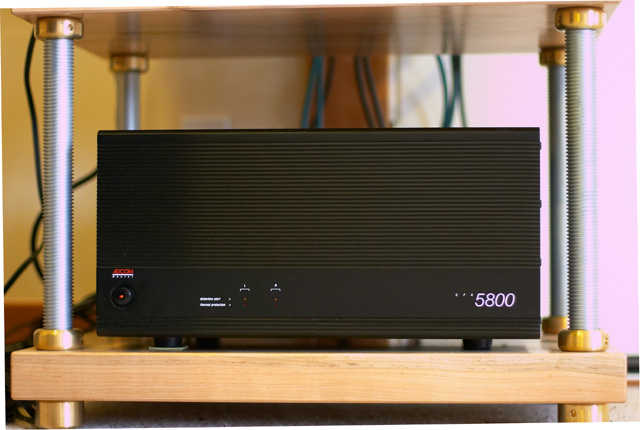
My power amp is an Adcom 5800.
It has plenty of juice to drive my big inefficient Magnepan speakers.
It operates in high bias class AB for low noise and distortion with plenty of power.
It's biased pretty high, drawing about 250 Watts sitting idle.
It can draw almost 2 Kilowatts from the wall while delivering 400 clean watts of continuous power
to each of my speakers, with 2 dB of headroom which amounts to 500 watts of peak power output.
Its noise floor is below -100 dB with low distortion and frequency response within 0.25 dB throughout the audible bandwidth.
The only problem I've had with this amp over the years is the power switch.
Every 5 years or so it fails, leaving the amp permanently ON.
I can only guess that the transient power draw when it is first turned on
causes some kind of cumulative wear on the switch.
It does have long arrays of capacitors filtering its power supply with its huge toroidal transformer.
When you turn it off the stored charge in these capacitors is enough to keep the music going
for a good 4 seconds at moderate volume levels.
All this capacitance means it looks like a short when the caps are empty and it's first turned on,
so for a fraction of a second it draws a huge amount of power.
On initial turn-on, it occasionally blows the 20 amp breaker for the outlet it's plugged into.
Every time I have its power switch replaced I have the guys bench test it for power, linearity and distortion.
I've owned it for over 10 years, it's on its 3rd power switch and so far has not required any other adjustments.
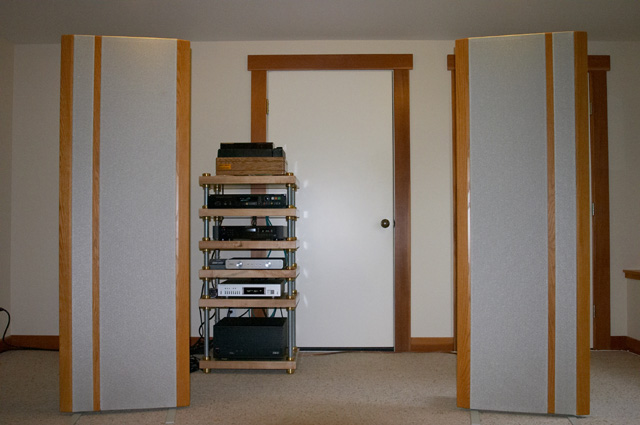
[The room may look stark, but these speakers require a hard, flat surface behind them - see below]
The audio rack is a Mapleshade Samson.
It has shelves made of 2" thick air dried maple, corner rods are 1.25" solid steel with solid brass hardware.
The solid brass feet feet taper to sharp points that penetrate the carpet & mat, resting on the concrete subfloor.
The empty rack alone weighs about 170 lbs. and it is rock solid as if were bolted to the floor.
The speakers are Magnepan 3.6/R.
They are planar magnetics having excellent frequency response and low distortion.
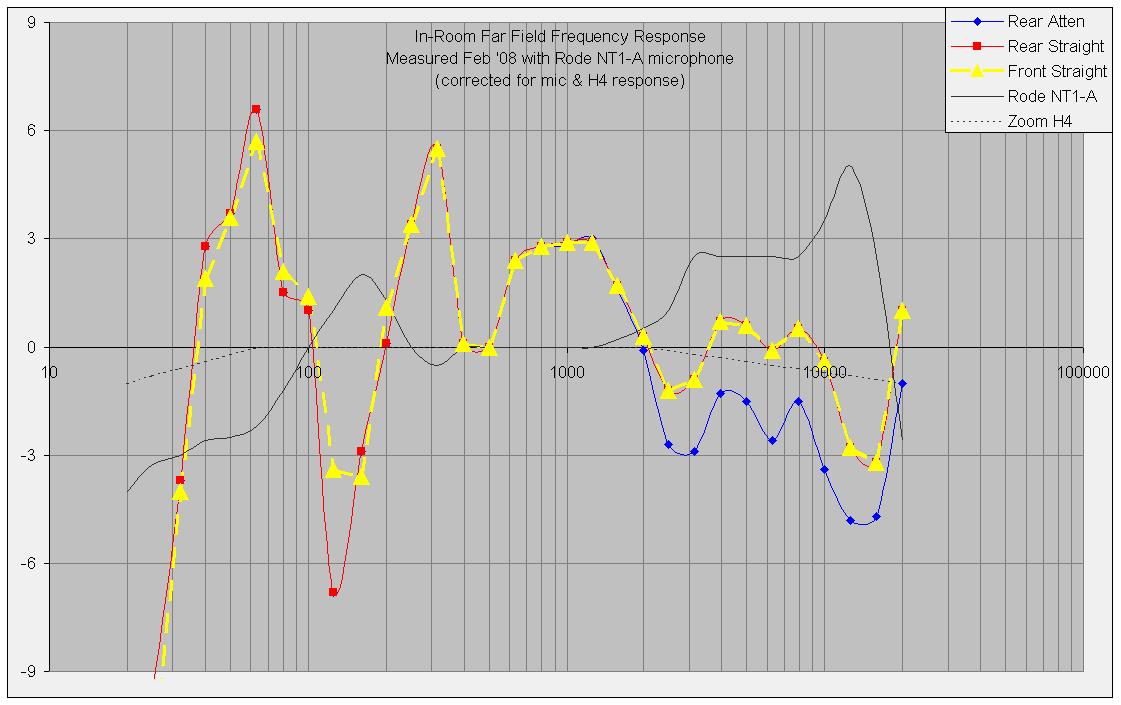
Here is their frequency response,
measured at the listening position in my room.
The yellow curve is the listener position.
The red curve is just behind the listener position (closer to the rear wall).
You can see that closer to the rear wall, the room's bass modes have more effect.
The blue curve is from the listener position, with 1 Ohm resistors attenuating the tweeters.
From 32 Hz to 20 kHz they are within 4 dB of flat response,
while producing audible sounds at 20 Hz.
This is the kind of response one might expect of a recording studio.
This is their actual response in my listening room -
not some theoretical specification from a manufacturer's marketing department.
I measured this using my Rode NT1-A large diaphragm condenser microphones,
using the 1/3 octave warble tones from Stereophile test CD #2 (tracks 16-18).
The curve is corrected for the mic's response curve.
How did I achieve this response?
The response in the original room setup had peaks & dips of around 14 dB.
I rearranged the room and applied RPG Profoam in strategic locations.
Rearranging the room always makes a big difference in sound,
but with dipoles it makes an even bigger difference than usual.
A dipole speaker has no enclosing box - the driving elements are exposed to the air on both front and back.
Dipoles radiate sound equally both forward and backward.
The back wave reflects off the wall behind the speaker and follows the front wave forward.
The distance to the rear wall determines the phase between the reflected and primary wave.
For example, suppose that distance is 5 feet.
Five feet is half a wavelength of 110 Hertz.
So at 110 Hertz, the reflected back wave is 180* (half a wavelength) out of phase with the front wave.
Theoretically this should cancel that frequency at the listener's ear.
Realistically, it doesn't entirely cancel the wave but it attenuates it,
usually by anywhere from 3 to 12 dB depending on various other factors about the room setup.
That same 5 feet is a full wavelength at 220 Hertz.
So at 220 Hertz, the reflected back wave is in phase with the front wave.
This should double the amplitude of the front wave which would amplify it by 6 dB.
Realistically, it boosts it by around 3-6 dB.
Now look carefully at the above FR curves again.
See the dip at 32 Hz?
Notice there is also a peak at 63 Hz and a dip at 130 Hz.
Here you see the above effects in action.
The fundamental is being cut, and each multiple of that frequency is alternately boosted and cut
as the wavelength is a multiple of the distance from the speakers to the back wall.
The degree of cut & boost diminishes for each successive multiple of the fundamental.
Knowing this effect helps one validate the accuracy of the measurements.
The Mag 3.6/R speakers are designed to boost 50 Hz by 6-9 dB in their near field response.
This is to compensate for the fact that most room setups will put them a distance from the rear wall
that is somewhere near 1/4 wavelength of 50 Hz - about 5 feet (more or less).
Similar effects occur with conventional speakers but they are less pronounced.
This can be good or bad, depending on one's perspective.
Sensitivity to room setup can make speakers a PITA,
requiring the entire room to be arranged around the speakers and listener position.
But it can also be A GOOD THING since it provides greater rewards to those who want to fine tune the response.
To get this response
I experimented with about 20 different room setups and mesaured and listened to each to find the best.
Some recordings are excessively bright and I wanted a way to attenuate the highs.
The resistor that came with these speakers for that purpose
had too high an R value (1.2 Ohms) and virtually turned off the tweeters.
It was also a standard Radio Shack variety resistor that seemed to veil up the sound.
I am using my own pair of Mills wire wound, noninductive high power resistors, 1 Ohm each.
As you can see in the graph, it provides 2 dB of attenuation through the upper midrange & treble,
which is just right for those overly bright recordings.
My turntable is a Thorens TD-318 Mk II.
It sits on the floating lid of a 150 lb. sandbox that I built myself.
The sandbox provides vibration isolation and the floating lid enables me to get the turntable perfectly level.
This is on top of wool berber carpet with a felt undermat on a solid concrete foundation.
I can jump up and down stomping the floor right next to it while recording a blank LP track
on my CD burner and the VU lights don't even blip at -50 dB.
Suffice to say this turntable picks up NO vibration.
My phono pickup is an Ortofon MC 30 Super Mk II low output moving coil.
I measured its frequency response and distortion using the Cardas Test LP,
recording the output on my CD Burner and analyzing it on my computer.
I used this to fine tune the cartridge alignment and loading.
Ortofon recommends 100 Ohms and 100-200 pF.
The ideal loading ended up being 30 Ohms and 100 pF.
This lower resistance tames the rising top end by about 1 dB.
Its response is excellent for an LP system:
-3 dB at 20 Hz, linearly rising to + 1.8 dB at 12 kHz and falling to -2 at 20 kHz.
It's within 2 dB of flat from 40 Hz to 20 kHz with an almost perfectly linear response curve.
With Ortofon's factory recommended loading, it is about +3 dB at 12 kHz.
Some people prefer this brighter sound and perceive it as an enhanced sense of detail or "air".
To my ears it sounds hyper-detailed and artificial.
I prefer the more realistic response.
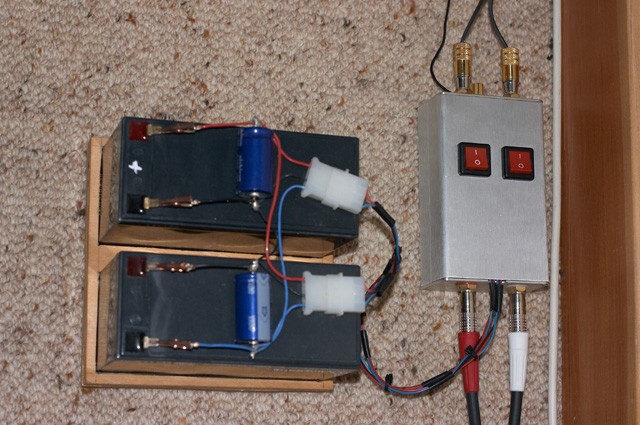
My phono amp is a
DACT CT-100.
I assembled it from a kit, and designed & built the power supply, box, connectors, etc.
This is the cleanest, most linear phono amp I have ever seen.
At least on paper, it is superior in every measurable way: bandwidth, noise, frequency linearity etc.
to even the most highly regarded (and expensive) phono amps.
It is also the most flexible I have seen.
It is dip switch selectable for gain (from 40 to 80 dB) and cartridge load (10 Ohm - 47k Ohms, 100 - 400 pF),
enabling it to drive virtually every phono cartridge on planet Earth,
and the ability for you to easily adjust loading to tune and optimize your cartridge frequency response.
It has a stiff output stage with an output impedance of 0.1 Ohm,
which makes it ideal for driving my 10k passive attenuator.
What does it sound like? Nothing!
Really good LPs are great - rich deep bass, smooth midrange, extremely fast treble, high resolution,
natural tonal balance that is not excessively warm or bright, effortless dynamics.
Even with the 70 dB of gain I use with my low output cartridge, there is no audible background floor of hum or noise.
On a super clean LP the music comes out of a spooky quiet dead silence.
Bad LPs sound... well... bad.
It is not a forgiving phono amp - it gives you the truth - you hear what the LP really sounds like, for better or for worse.
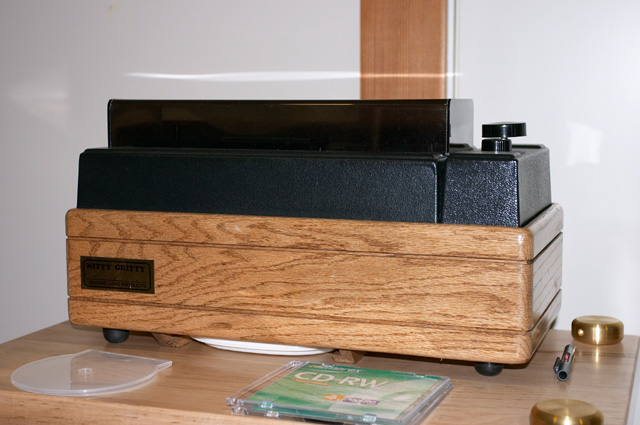
Vinyl doesn't sound good unless it's clean, and that is the job of my Nitty Gritty 2.5 FI record cleaner.
I brew my own cleaning solution distilled water and isopropyl alcohol; here's the
recipe.
It has a replaceable "vac-sweep" pad with small holes through which cleaning fluid is injected
while it slowly spins the record.
After a few turns you flick the switch and a powerful vacuum draws from the center of the vac-sweep pad
while the record continues to spin.
It does the job as well as it can be done - nothing I know of gets records cleaner.
After a few years it did have a problem - the fluid started leaking!
I took it apart to find it was leaking where the hoses inside connect to the fluid tank.
I took it apart and glued them back several times,
trying 5 minute expoxy, 60 minute epoxy, marine epoxy and adhesive caulk.
None of them worked - each time, eventually the alcohol solution would eat them up and leak out.
I was almost ready to buy a new one until I saw the price: about $1 kilobuck.
That is more than twice what I paid for mine about 12 years ago!
For that price I was determined to fix it myself.
Finally, I found something that worked:
PC-11 epoxy.
This stuff does the job and the cleaning solution never eats it away or leaks out.

My Tuner is a
Sangean HDT-1X.
It is an HD Radio tuner with a unique design.
You can read more about it
here.
It has excellent sensitivity, tunes HD Radio stations, and has great sound quality.
It has a digital optical output which connects directly to my CD burner,
so I can bypass unnecessary D->A and A-> stages when recording.
I have a large outdoor FM television type antenna that really pulls in the stations.
Even though Seattle is about 75 miles away, it pulls in stations including HD Radio with crystal clarity.
My speaker cables are regular old 12 gauge fine stranded copper with locking banana plugs soldered on.
Most of my RCA interconnect cables are Tara Labs Prism 22.
They have nicer shielding and more solid connectors than regular old cheap cables.
My phono amp to attenuator connection is 12 feet long,
so I used a cable with excellent shielding and extremely low capacitance:
Blue Jeans Cable LC-1.
At 12.2 pF / foot its capacitance is low enough for long runs.
I also use this (in 2' lengths) for my attenuator-amplifier connection,
because of the attenuator's high output impedance.







